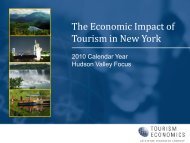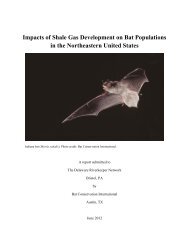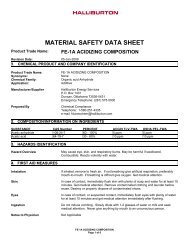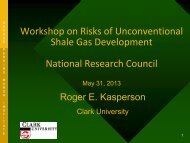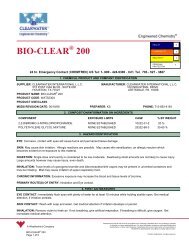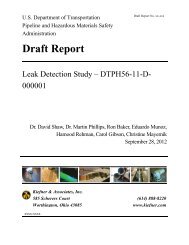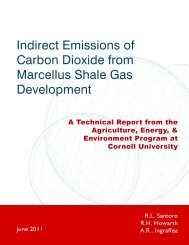Gulf Coast Coal and Petrochemical Facilities Still Not Storm Ready
Gulf Coast Coal and Petrochemical Facilities Still Not Storm Ready
Gulf Coast Coal and Petrochemical Facilities Still Not Storm Ready
You also want an ePaper? Increase the reach of your titles
YUMPU automatically turns print PDFs into web optimized ePapers that Google loves.
– 11 –<br />
plants, <strong>and</strong> oil refineries. GRN also documented the state of coastal <strong>and</strong> marshl<strong>and</strong> restoration<br />
projects, checking the status of wetl<strong>and</strong> <strong>and</strong> barrier isl<strong>and</strong> restoration projects—valuable<br />
defenses against storm surge.<br />
● Lower Mississippi Riverkeeper conducted on-the-ground assessments of environmental<br />
damage in storm-impacted communities across southern Louisiana, including documenting<br />
hazardous waste containers from the Stolthaven refining <strong>and</strong> storage facility that were washed<br />
away by floodwaters <strong>and</strong> deposited downstream in the batture * of the Mississippi River.<br />
● SouthWings conducted a post-storm flight with Lower Mississippi Riverkeeper, GRN, <strong>and</strong><br />
LABB to collect aerial observations of suspected pollution from fossil fuel <strong>and</strong> petrochemical<br />
sites impacted by the storm. SkyTruth provided satellite image analysis <strong>and</strong> mapped NRC<br />
report data to support flight planning; <strong>and</strong> LABB filed 10 reports 24 with the NRC documenting<br />
pollution observed during the flight.<br />
GMC in the Field<br />
By <strong>Gulf</strong> Restoration Network<br />
GRN, one of the newest GMC members, is a group committed to uniting <strong>and</strong> empowering people to<br />
protect <strong>and</strong> restore the natural resources of the <strong>Gulf</strong> Region. Working to coordinate responses to a<br />
variety of pollution events caused by Hurricane Isaac, GRN coordinated with numerous <strong>Gulf</strong> region<br />
partners to document pre-Isaac conditions <strong>and</strong> the aftermath on the ground, out on the water, <strong>and</strong> in<br />
the air. GRN <strong>and</strong> their partners found the following impacts:<br />
● 17 NRC reports filed for oil, chemical, <strong>and</strong> coal pollution<br />
● <strong>Coal</strong> <strong>and</strong> chemical storage facilities with insufficient levees resulting in flooding <strong>and</strong> pollution<br />
● Oil from the BP/Deepwater Horizon Disaster is still washing up on shore<br />
● Dead wildlife found on the beaches <strong>and</strong> domestic livestock seen drinking from contaminated<br />
water near coal terminals<br />
On August 25, just days before Hurricane Isaac arrived on the Louisiana coast, GRN conducted a<br />
flyover with SouthWings <strong>and</strong> captured aerial images of industrial facilities along the Mississippi river<br />
in Plaquemines <strong>and</strong> St. Bernard parishes. GRN was concerned that the impending storm defense<br />
systems at facilities like the Kinder Morgan IMT <strong>and</strong> the Phillips 66 Alliance Refinery would not be<br />
adequate to withst<strong>and</strong> hurricane force winds <strong>and</strong> storm surge.<br />
On September 2, in the immediate aftermath of Hurricane Isaac, GRN took a monitoring flyover to<br />
some of the same facilities from the prior week <strong>and</strong> documented visual evidence that the internal<br />
levees at numerous facilities failed to withst<strong>and</strong> the pressure from Isaac’s wind, rain <strong>and</strong> surge.<br />
Having taken the August 25 flight, GRN could now provide before <strong>and</strong> after geotagged images for<br />
those locations. From the air, GRN was able to discover, document <strong>and</strong> file NRC reports with the<br />
<strong>Coast</strong> Guard. A total of 6 NRC reports were filed for this particular monitoring trip <strong>and</strong> included<br />
incident report numbers: 1023144, 1023150, 1023151, 1023153, 1023147, <strong>and</strong> 1023154. Our flight<br />
took us over the following (but not limited to) heavily impacted communities, industrial facilities, oil<br />
<strong>and</strong> gas infrastructure, barrier isl<strong>and</strong>s, <strong>and</strong> other locations: the communities of Braithwaite, Ironton,<br />
Delacroix, Lafitte, Myrtle Grove, <strong>and</strong> Gr<strong>and</strong> Bayou; the Phillips 66 Alliance Refinery, United Bulk coal<br />
terminal, <strong>and</strong> Kinder Morgan IMT; Breton Isl<strong>and</strong> <strong>and</strong> the Ch<strong>and</strong>eleur Isl<strong>and</strong>s.<br />
* The batture is the l<strong>and</strong> area between a levee <strong>and</strong> the edge of a river, a term commonly used along the Lower Mississippi<br />
River.




